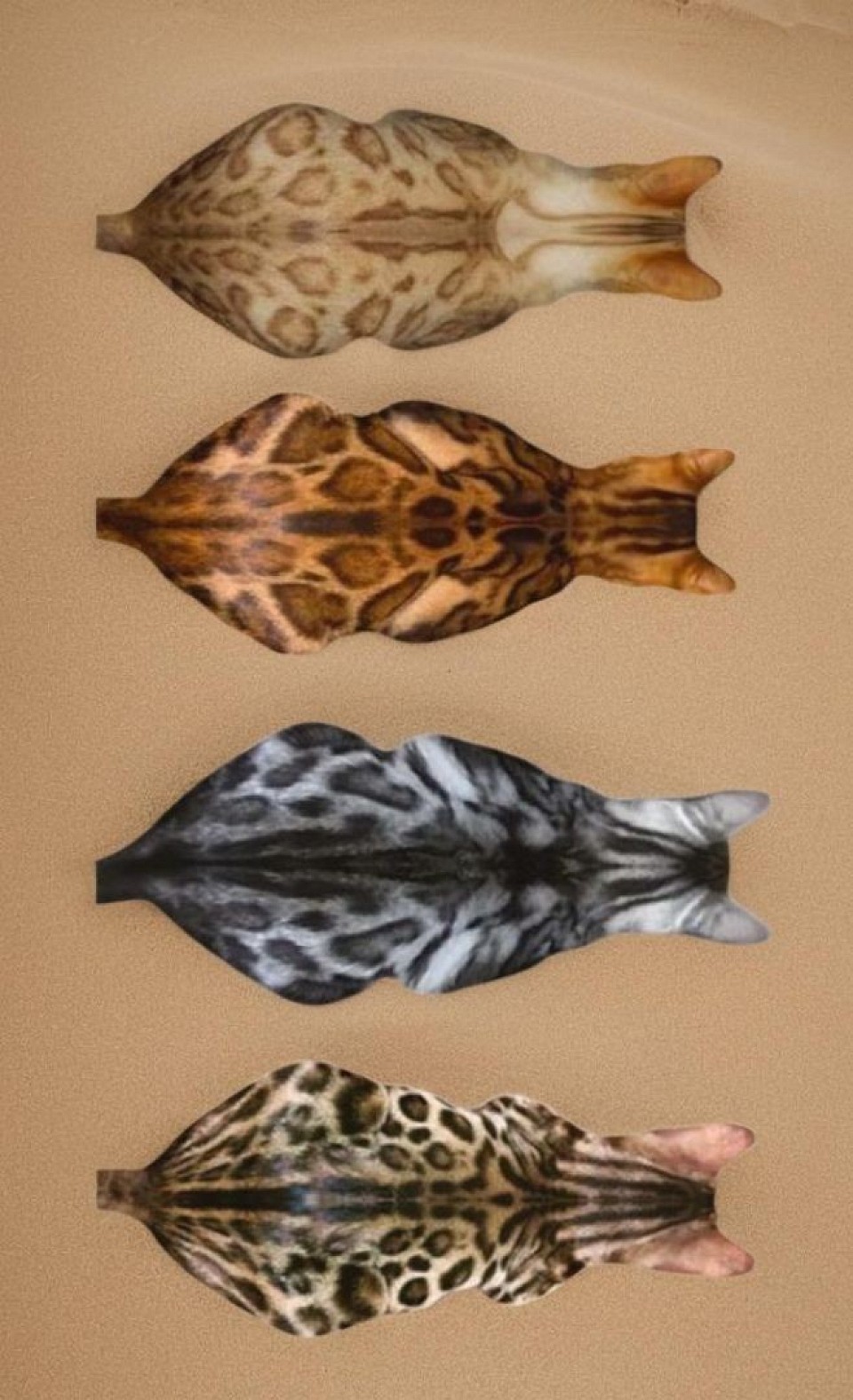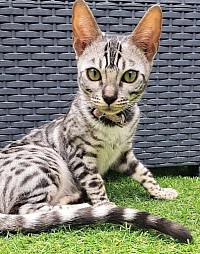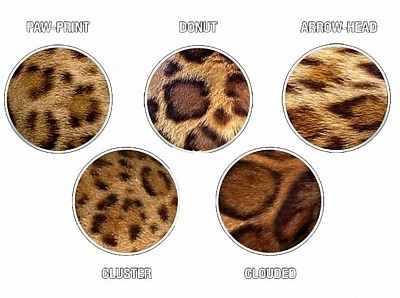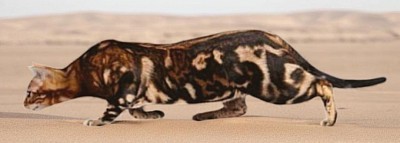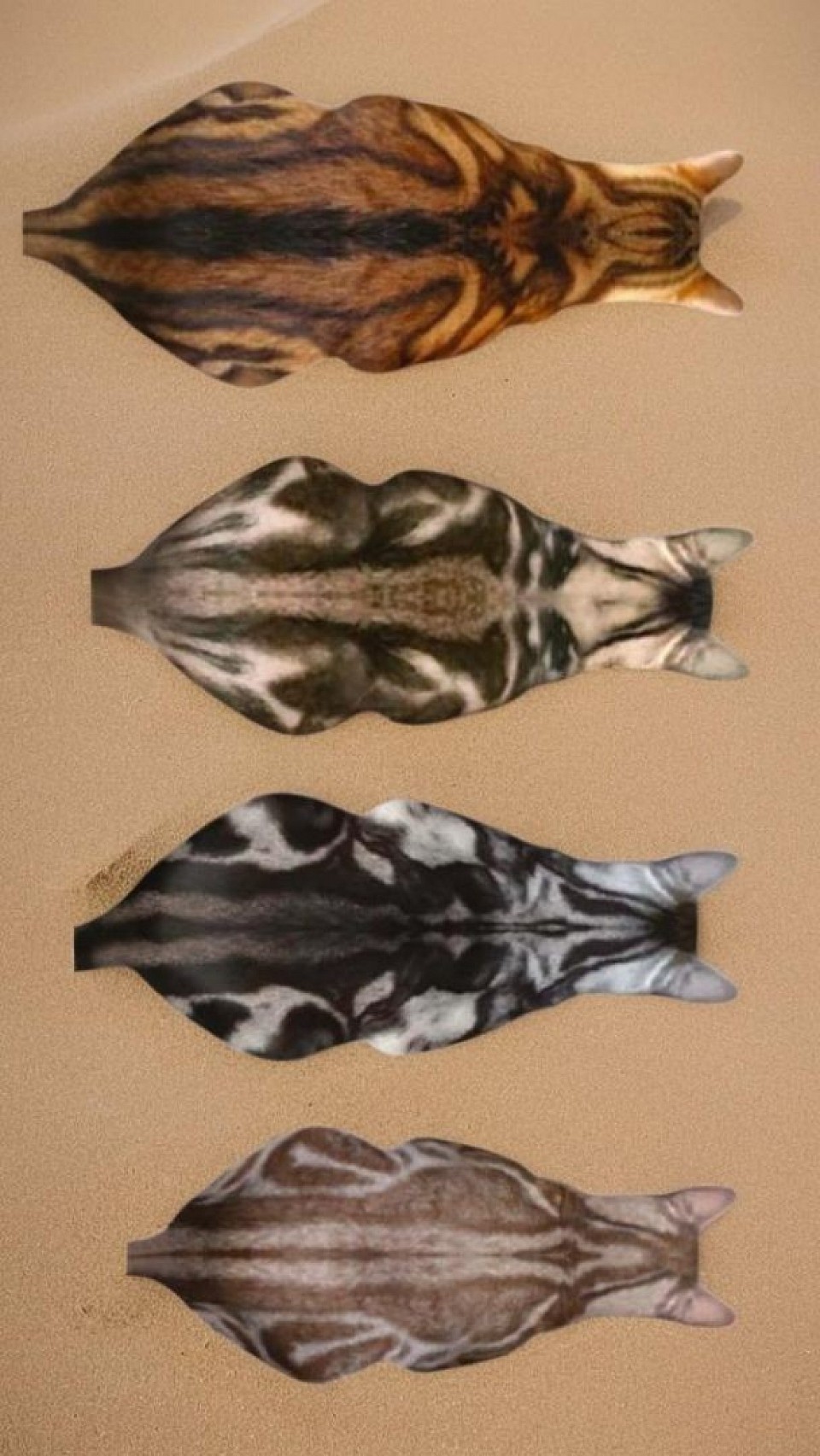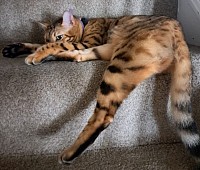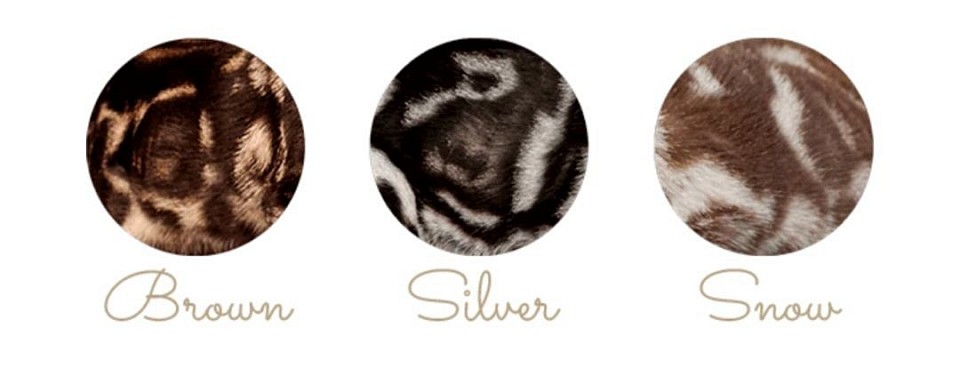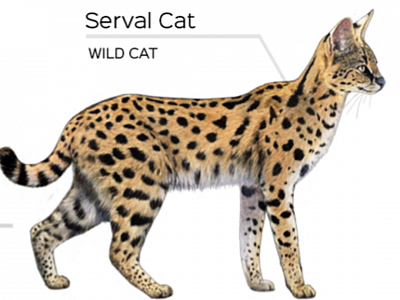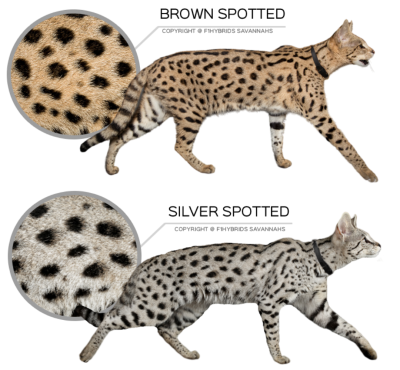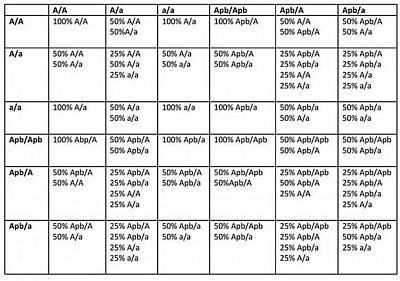Coat: Colour and Patterns
spotted
A spotted coat Bengal cat is such a delightful sight! It’s the most popular style of coat, and it’s no wonder why. If you’ve ever come across a Bengal cat or are just discovering the wonders of these fascinating felines, chances are you’ve seen one in its gorgeous spotted form. Their playful patterns and vibrant personalities make them truly captivating companions!
Spotted Bengal Cats
Spotted Bengal Cats
The distinctive spots of the Bengal cat are inspired by various wild feline species worldwide, resulting in coat patterns unparalleled in domestic cats. In the wild, these markings have evolved over millennia, enabling these cats to blend seamlessly into their environment. This camouflage allows them to remain concealed within vegetation, shadows, and shade, significantly enhancing their hunting success by avoiding detection. Additionally, their intricate patterns serve to disrupt the night vision of their prey.
In Bengal cats, the spotted pattern should appear random, diagonal, or horizontal, with a lighter background colour that provides striking contrast to the spots. These spots range from small, singular monochrome dots to diverse rosette types, where larger, two-toned spots are present. Many Bengals exhibit multiple rosette varieties on their coats.
At Angeldust Bengals, each kitten is uniquely exquisite, bred to showcase large, dramatic rosettes designed to captivate and impress.
Below are the various spot types characteristic of the Bengal breed:
Arrowhead Rosettes
Arrowhead rosettes draw inspiration from the Asian leopard cat, the original wild ancestor crossed with domestic cats to create the Bengal. These rosettes are striking, shaped like arrows with tips pointing toward the cat’s rear. Their fluid, horizontal arrangement imparts a sense of motion, even when the cat is stationary.
Clouded Rosettes
Clouded rosettes are modeled after the clouded leopard’s markings. These large, cloud-like shapes often resemble snakeskin patterns, typically beginning at the shoulders and extending down the tail. The rosettes fit closely together, with minimal spacing, creating a puzzle-like effect.
Paw Print Rosettes
Inspired by the leopard, paw print rosettes resemble the shape of a paw, featuring a central spot akin to a paw pad surrounded by darker spots resembling toes. These rosettes are never fully closed and are densely clustered.
Donut Rosettes
Doughnut rosettes take their cue from the jaguar. These bold rosettes are large with more spacing between them. Each has a fully dark outline encircling a lighter centre, which remains darker than the Bengal’s ground colour. Occasionally, tiny spots appear within each doughnut. When exceptionally large, these rosettes are referred to as pancake rosettes.
Single Spotted Rosettes
Single spotted rosettes are inspired by the cheetah, featuring monochrome spots scattered over a contrasting background. While less favoured among contemporary Bengal breeders, single-spotted Bengals remain vital to the breed due to their excellent structure, type, and the horizontal flow of their spots.
Blue
Blue Bengal cats are truly a delight to behold! Their stunning powder blue and grey coats, accented with soft cream tones, create a breathtaking look. With their unique spotted or marbled patterns in rich dark blue or metallic grey, these cats bring a touch of elegance to any home.
It's fascinating to know that the beautiful blue colour comes from a recessive gene, meaning both parents must carry it to welcome a blue Bengal into the family. Each time a blue Bengal is born, it’s a special celebration!
Black
Solid black Bengals are like little mysteries wrapped in beauty! With their stunning black patterns on a rich black background, they evoke the enchanting allure of black panthers, those majestic creatures we all adore.
These captivating cats have patterns known as “ghost markings” or “ghost spots” that softly emerge in the daylight, creating a magical effect reminiscent of the shadows of leopards and jaguars. It’s like having a mini black panther right at home!
While black Bengals might be a bit rare and don’t always get the spotlight with breeders, their uniqueness makes them even more special. The hues of their spots can range from subtle dark brown to deep black, revealing their charm beautifully when caught in the sun.
If you’re on the lookout for a purrfect companion that embodies the spirit of the wild, a solid black Bengal is definitely your best bet! Friend, adding even more variety to this gorgeous feline family!
Silver Charcoals
Charcoals are such beautiful creatures, sporting a delightful dark greyish or brownish backdrop that exudes a warm, earthy charm! Their fascinating patterns are like little works of art, with hints of very light rufous (a lovely reddish-brown) sprinkled in. Just imagine those stunning spotted or marbled designs adding character to their coat!
One of the most charming features of charcoals is their distinctive “mask,” which gives them a playful, mysterious vibe! This delightful face mask, often darker in hue, resembles an upside-down “Y” or even a peace sign without the circle, adding to its unique allure. The way these masks can deepen in colour to match their striking black body markings is simply enchanting!
And let’s not forget about their tail, which is a beautiful dark brown/black or greyish black adorned with stripes and a cheerful black tip that completes their look. It’s like a little flag waving in excitement!
Charcoal browns and charcoal silvers are particularly striking, flaunting a sleek black body decorated with subtle “ghost” markings that can remind one of magical shadows! They’re so eye-catching that they might even be mistaken for solid colour Bengals! And just think of the fascinating diversity within this breed—solid black Bengals, known affectionately as “melanistics,” and the lovely “silver smokes” add to the charm of these captivating kitties!
Isn’t it wonderful how such unique features come together in charcoals, making them truly special pets filled with personality? Th stripes and a cheerful black tip that completes their look. It’s like a little flag waving in excitement!
Charcoal
The magnificent charcoal Bengal, often referred to as Apb, showcases a stunningly darker appearance that truly stands out from the traditional Bengal colours! This beautiful black smoky charcoal colouration is especially vibrant in the early generation F1 and F2 Bengals, making them a sight to behold.
What’s even more exciting is that the charcoal trait is inherited independently of the cat’s colour, allowing it to shine across all colour classes! Whether it’s browns, silvers, or snows (which include delightful variations like lynx charcoal, mink charcoal, and sepia charcoal), each combination brings its own unique charm. This enchanting trait can even be found in blues and other snow varieties, adding to the joyful diversity of these incredible cats. Isn’t it wonderful how the beauty of the charcoal Bengal can enhance the joy of any feline lover?
Silver
Silver Bengal cats are simply enchanting! Their unique Silver (I, i or I, I inhibitor) genes create a beautiful lack of colour that results in an almost white base coat, beautifully contrasted with stunning dark markings. It’s like a canvas of striking artistry!
These gorgeous felines come in a delightful variety of shades, with backgrounds ranging from pure white to deep, shimmering steel. And the fun doesn't stop there! You can find silvers in all sorts of playful combinations—how about a Silver Snow or a captivating Silver Charcoal? Just think of all the delightful possibilities, like Blue Silver too!
A silver Bengal truly shines with minimal tarnish (no yellow or rusty brown here!), displaying lovely dark grey to jet black markings, a black-tipped tail, a charming brick-red nose, and mesmerising green or golden eyes.
Snow Seal Sepia
A Snow Seal Sepia Bengal (Cb, Cb colour genes) is a delightful sight to behold! With its stunning ivory, cream, and light tan hues, this breed brings a touch of elegance to any home. The enchanting shades of seal sepia markings, complemented by a charming dark seal brown tail tip, only add to its allure. And let's not forget those mesmerising green or gold eyes that sparkle with personality!
Snow Seal Mink
Snow Seal Mink Bengal (with Cb, Cs colour genes) is equally enchanting! Imagine a beautiful blend of ivory, cream, and light tan tones, boasting varying shades of seal mink markings that dance across its coat. With a dark seal brown tail and mesmerising blue-green or aqua eyes, this kitty radiates happiness and allure! Each one is a true treasure, bringing joy to any home!,
Snow Seal Lynx
A Snow Seal Lynx Bengal (with Cs, Cs colour genes) is a delightful sight! Picture a gorgeous feline adorned in a very light white cream coat, complemented by striking dark or light seal markings. It features a charming dark seal brown tail tip and those captivating blue eyes that sparkle with joy!
Brown
The ground colour can range from a grey-tawny tone to a vivid orange-gold.
The spotting, rosetting or marbling colour can range from black, light brown, to a darker or reddish brown.
If you have a brown furry friend, you probably know that brown comes in a variety of shades like: Golden, Cream, Tawny, Honey, Taupe, Tan, Beige, Caramel, and Cinnamon.
All shades of brown are accepted, but an orange-brown is preferred for ground colour.
As you can see, there’s virtually every shade of brown available for the Bengal breed.
Now, with a brown Bengal, you can find these characteristics:
Brown to jet black markings black tip tail, red nose, brown, copper, gold, green or hazel eyes white belly are preferred
Marbled
The marbled coat pattern of the Bengal cat is a joyful spectacle, derived from the delightful blotched tabby stripes that swirl in harmony! Picture the ideal marble Bengal cat, boasting a vibrant, flowing design that dances across its fur—a mesmerising, asymmetrical pattern of swirls in two or more enchanting colours. It's like nature’s own work of art, bursting with life and beauty! It, flowing design that dances across its fur—a mesmerising, asymmetrical pattern of swirls in two or more enchanting colours. It's like nature’s own work of art, bursting with life and beauty!
Savannah Coat Markings
The colours of the Savannah Cat are striking: brown, silver, black, and smoke. Acceptable colours are those that mimic the appearance of the African Serval. The most prevalent variation of the African Serval boasts a stunning buttery gold hue adorned with solid jet black spots. Since gold falls within the brown spectrum, it is accurately classified as a brown spotted tabby (BST).
- Brown Spotted Tabby = Aguoti Cat (A-)
- Silver Spotted Tabby = Aguoti Cat (A-) + Inhibitor gene
- Black = Non-Aguoti Cat (AA)
- Smoke = Non-Aguoti Cat (AA) + Inhibitor gene
This classification clearly defines the magnificent variety within this breed!
Here below you can see a schedule of the different combinations
Lid-colorednying chart delineates the potential offspring genotypes arising from various pairings of the Agouti gene alleles in Bengal cats: A, a, and Apb. This gene predominantly governs the presence and type of coat pattern (spotted or marbled) and is integral to the distinctive "charcoal" colouration.
Below is an overview of the genotypes and their relevance in Bengal cat genetics:
A/A (Homozygous Agouti):
These cats exhibit a standard patterned coat (spotted, rosetted, or marbled) without carrying the non-agouti or charcoal alleles.
Crosses involving A/A:
- A/A x A/A: 100% A/A offspring, all patterned.
- A/A x A/a: 50% A/A, 50% A/a; half patterned without non-agouti, half patterned carrying non-agouti.
- A/A x a/a: 100% A/a; all patterned carriers of the non-agouti gene.
- A/A x Apb/Apb: 100% Apb/A; all patterned carrying the ALC Agouti gene.
- A/A x Apb/A: 50% A/A, 50% Apb/A; half patterned, half patterned carrying the ALC Agouti gene.
- A/A x Apb/a: 50% Apb/A, 50% A/a; half patterned carrying ALC Agouti, half patterned carrying non-agouti.
A/a (Heterozygous Agouti/Non-Agouti Carrier):
These cats display a patterned coat but carry the recessive non-agouti gene, enabling the production of solid (melanistic) offspring if bred with another carrier of the "a" allele.
Crosses involving A/a:
- A/a x A/a: 25% A/A, 50% A/a, 25% a/a; potential for solid-colored kittens (a/a).
- A/a x a/a: 50% A/a, 50% a/a; yields patterned carriers and solid cats.
- A/a x Apb/Apb: 50% Apb/A, 50% Apb/a; produces patterned carriers and charcoal cats.
- A/a x Apb/A: 25% Apb/A, 25% Apb/a, 25% A/A, 25% A/a; a mixture of patterned and charcoal offspring.
- A/a x Apb/a: 25% Apb/A, 25% Apb/a, 25% A/a, 25% a/a; can produce patterned, charcoal, and solid kittens.
a/a (Homozygous Non-Agouti):
These cats are solid-colored (melanistic) due to the non-agouti gene suppressing the tabby pattern.
Crosses involving a/a:
- a/a x a/a: 100% a/a; all offspring solid.
- a/a x Apb/Apb: 100% Apb/a; all offspring charcoal.
- a/a x Apb/A: 50% Apb/a, 50% A/a; produces charcoal and patterned carriers.
- a/a x Apb/a: 50% Apb/a, 50% a/a; yields charcoal and solid cats.
Apb/Apb (Homozygous Asian Leopard Cat Agouti):
Often termed "double charcoals," these cats exhibit a charcoal appearance, though a true charcoal requires the presence of the recessive a allele.
Crosses involving Apb/Apb:
- Apb/Apb x Apb/Apb: 100% Apb/Apb.
- Apb/Apb x Apb/A: 50% Apb/Apb, 50% Apb/A.
- Apb/Apb x Apb/a: 50% Apb/Apb, 50% Apb/a.
Apb/A (Heterozygous Asian Leopard Cat Agouti):
These cats are patterned and carry the ALC Agouti gene.
Crosses involving Apb/A:
- Apb/A x Apb/A: 25% Apb/Apb, 50% Apb/A, 25% A/A.
- Apb/A x Apb/a: 25% Apb/Apb, 25% Apb/A, 25% Apb/a, 25% A/a.
Apb/a (Charcoal):
These cats display the characteristic "charcoal" pattern, distinguished by a dark facial mask and a dorsal "cape" stripe.
Crosses involving Apb/a:
- Apb/a x Apb/a: 25% Apb/Apb, 50% Apb/a, 25% a/a; capable of producing double charcoals, charcoals, and solid cats.
This chart serves as a valuable tool for Bengal breeders to anticipate genetic outcomes and potential coat colours and patterns in kittens based on the parental genotypes.
In Other Words
The genetics of Bengal cats are notably complex. To begin, the genetic alleles a Bengal cat may carry are detailed below. These genes influence a variety of coat colours, including silver, brown, and several snow variants. Although a cat’s phenotype may present a single colour, it can harbour multiple genetic alleles that are not externally visible.
1. A/A genotype:
Represents a typical Agouti/tabby cat exhibiting striped or spotted patterns, including marbled or rosetted variations.
2. a/a genotype:
Corresponds to a solid-colored cat, such as black (melanistic) or mink-colored. Occasionally, faint spots may be discernible beneath the solid coat. For a kitten to be solid-colored, both parents must carry and transmit the recessive a allele.
3. A/a genotype:
Indicates a normal Agouti/tabby cat carrying the non-agouti (a) gene. The cat does not express the solid phenotype, as the dominant A allele masks the recessive a allele.
4. Apb/a genotype:
Defines a charcoal cat, inheriting both the Apb (charcoal) gene and the recessive a (non-agouti) gene. Charcoal Bengals are characterised by a dark facial mask and a distinctive "zorro" cape-like marking.
5. Apb/Apb genotype:
Known as ‘double charcoal.’ While not a true charcoal (which requires the recessive a gene), double charcoals exhibit a dark mask and a darker back, though less intense than true charcoals.
6. Apb/A genotype:
Describes a typical spotted, striped, or marbled Agouti cat carrying the Apb gene without expressing the charcoal phenotype.
The Genetics of the Bengal
Gene Functionality
It is fundamental to recognise that genes exist in pairs.
During oogenesis, each egg receives one-half of the dam’s gene pair; the other half is allocated to a different egg. Similarly, sperm cells each carry one half of the sire’s gene pair.
Upon fertilisation, the sperm and egg combine their gene halves to reconstitute a gene pair. Consequently, barring exceptional circumstances, a kitten inherits half of its genes from the dam and half from the sire.
It is a misconception that the sire’s genes are inherently “stronger” than the dam’s. Both parents contribute equally to the kitten’s genetic makeup, as each inherits half their genes from the other. The phenotype depends on the interaction of these genes.
Distinct genes influence coat pattern (spotted or marbled), coat colour (brown, snow, blue, silver, chocolate, cinnamon), and coat type (long or short hair). Each gene fulfils a specific role.
Dominant and Recessive Genes
Genes may be dominant or recessive.
A gene pair can consist of two dominant genes, two recessive genes, or one of each. When a cat possesses one dominant and one recessive gene, the dominant gene’s trait is expressed, while the recessive gene is typically masked.
For example, the short hair gene is dominant over the long hair gene. Thus, a cat heterozygous for short and long hair will exhibit a short-haired phenotype.
Some genes exhibit incomplete dominance, where dominance is partial, resulting in intermediate phenotypes.
Terminology: Homozygous and Heterozygous
These terms describe gene pair compositions.
A cat is homozygous if it carries two identical alleles for a trait. For example, a long-haired cat with two long hair alleles is homozygous for long hair; similarly, a short-haired cat with two short hair alleles is homozygous for short hair.
A cat is heterozygous if it carries two different alleles for a trait. For instance, a short-haired cat with one short hair allele and one long hair allele is heterozygous.
Gene Combination
A practical approach to predict potential kitten genotypes is to construct a gene combination chart.
Using the short and long hair genes as an example, create a 3x3 grid, omitting the top-left cell. Populate the top row with the sire’s alleles and the left column with the dam’s alleles.
In this example, both sire and dam are heterozygous, carrying one short hair allele (L) and one long hair allele (l). Dominant alleles are denoted by uppercase letters (L), and recessive alleles by lowercase letters (l).
Male Short Hair (L)Long Hair (l) Female Short Hair (L)Long Hair (l)
Combine the male’s left-hand allele with the female’s top allele:
Male Short Hair (L)Long Hair (l) Female Short Hair (L)L L Long Hair (l)
Next, combine the male’s left-hand allele with the female’s bottom allele:
Male Short Hair (L)Long Hair (l) Female Short Hair (L)L L Long Hair (l)L l
Repeat this process for the male’s right-hand allele:
Male Short Hair (L)Long Hair (l) Female Short Hair (L)L LI LLong Hair (l)L l
Male Short Hair (L)Long Hair (l) Female Short Hair (L)L LI LLong Hair (l)L ll l
The resulting combinations are:
Male Short Hair (L)Long Hair (l) Female Short Hair (L)L LI LLong Hair (l)L ll l
Top-left cell (L L): homozygous short hair; the kitten will be short-haired.
Top-right and bottom-left cells (Ll): heterozygous short hair; kittens will be short-haired but carry the long hair allele (recessive and not expressed).
Bottom-right cell (l l): homozygous long hair; the kitten will be long-haired.
Thus, on average, this mating yields 50% heterozygous short-haired kittens, 25% homozygous long-haired kittens, and 25% homozygous short-haired kittens.
Note that these are statistical averages. Factors such as egg viability, sperm motility, and embryo survival influence actual outcomes. Therefore, consistent results require multiple matings.
This charting method can be applied to predict coat type, pattern, or colour for various genes, though complexity increases significantly with multiple genes due to combinatorial expansion.
For example, considering two genes (e.g., pattern and colour) results in 16 possible combinations, increasing chart complexity.
As an illustration, consider a mating between two brown spotted Bengals carrying marble and snow genes. Marble is recessive to spotting, and snow is recessive to brown.
MaleSpotted & SnowMarble & SnowSpotted & BrownMarble & BrownFemaleSpotted & Snow2x spotted genes
2x snow genes
= snow spotted1 spot + 1 marble
2x snow genes
= snow spotted2x spotted genes
1 brown + 1 snow
= brown spotted1 spot + 1 marble
1 brown + 1 snow
= brown spottedMarble & Snow1 spot + 1 marble
2x snow genes
= snow spotted2x marble genes
2x snow genes
= snow marble1 spot + 1 marble
1 brown + 1 snow
= brown spotted2x marble genes
1 brown + 1 snow
= brown marbleSpotted & Brown2x spotted genes
1 brown + 1 snow
= brown spotted1 spot + 1 marble
1 brown + 1 snow
= brown spotted2x spotted genes
2x brown genes
= brown spotted1 spot + 1 marble
2x brown genes
= brown spottedMarble & Brown1 spot + 1 marble
1 brown + 1 snow
= brown spotted2x marble genes
1 brown + 1 snow
= brown marble1 spot + 1 marble
2x brown genes
= brown spotted2x marble genes
2x brown genes
= brown marbled
From this mating of two brown spotted Bengals carrying marble and snow, the expected distribution (per 16 kittens) is:
3 snow spotted (2 carrying marble)
9 brown spotted (2 carrying snow, 4 carrying snow and marble, 1 carrying marble, and 1 homozygous)
1 snow marble
3 brown marbles (2 carrying snow)
Bengal Genes Overview
The following outlines the primary genes influencing Bengal cats, along with explanations. Research is ongoing, and new genes continue to be identified. If you possess additional information, please contact me (details at the bottom of the page).
Some genes listed do not directly pertain to Bengals but provide context for differences in other breeds.
Dominant / Recessive / Notes
A / a: Agouti / non-agouti
Agouti denotes tabby/patterned cats; non-agouti denotes solid-colored cats.
A is dominant over a, though not always completely; heterozygous black cats (Aa) may show faint tabby shadows.
A combined with the Inhibitor gene (I) can produce smoke coats.
B / b: Black / chocolate
b represents the chocolate gene, replacing black with rich chocolate brown.
B is incompletely dominant over b; Bb cats may exhibit black with rusty shading.
b is incompletely dominant over b1b1 (cinnamon).
b1 denotes cinnamon, replacing black with rich cinnamon brown.
b1b1 cats are cinnamon; b b1 cats often appear pale chocolate.
C / c: Full colour/albino
c denotes albino cats with no colour and pink eyes (not relevant to Bengals).
Ca denotes blue-eyed white cats (not related to Bengals).
Cs denotes Siamese (ivory background, colored points, blue eyes - blue-eyed snow).
Cb denotes Burmese (ivory background, darker sepia points, brown/yellow/green eyes).
Heterozygous cs/cb results in Seal Mink (Tonkinese colour) with turquoise eyes.
D / d: Dense colour / dilute colour
Dense colour is fully dominant over dilute colour.
Examples:
BBDD = black cat
BBdd = blue cat
bbdd = lilac cat
b1b1dd = fawn cat
Odd (sex-linked orange) = cream cat
Agouti (A) combined with dilute (d) produces a cream base coat.
Dm/dm: Dilute modifier / normal dilution
Dm modifies dilution effects when dd is present.
On blue, lilac, and fawn cats with Dm = caramel colouring.
On red cats with Dm = apricot colouring.
I/i: Colour inhibitor / normal colour
The inhibitor gene is dominant and suppresses coat colouring/It may be incomplete colour dominant or influenced by other factors, as some silv colour has a brownish “tarnish.”
Agouti (AA) combined with inhibitor (I) can cause smoke coats.
Variation in inhibitor and agouti gene strength may affect smoke expression.
Other unidentified genes may also influence silver phenotypes.
L / l: Short hair / long hair
Short hair is completely dominant over long hair.
Selective breeding influences hair length, possibly by selecting for other modifier genes.
Mc/mc: Vertical flow / circular flow
Mc produces vertical stripes or patterns.
Mc causes swirling or circular patterns.
mz: Horizontal flow
Theoretical gene believed to cause horizontal pattern alignment unique to Bengals, inherited from the ALC.
Mi/mi: Not glittered/glittered
Theoretical gene responsible for the glitter effect on Bengal coats.
Also referred to as Gi or Gl.
Glitter results from hollow hair tips allowing light transmission.
Rf/rf: Normal colour / rufous
Initially thought to be polygenes, rufous is now considered a separate gene causing red pigmentation.
Some theories suggest the extension gene may influence rufous colouring.
Red intensity varies among Bengals, possibly due to gene strength or modifiers.
S / s: White spotting / no white spotting
Incomplete dominance: Ss cats exhibit some white spotting.
SS = Harlequin or Van pattern (>2/3 white)
Ss = Bicolor (~2/3 white)
The cause of the locket marking remains uncertain; it may be a variant of this gene.
Sa / sa: Normal hair / satin or silk fur
Theoretical gene producing minimal undercoat and a satin finish.
Some suggest this gene may influence glitter, though this is debated.
Sp: Pattern interrupt
Identified as a gene that breaks up tabby patterns into spots rather than lines.
Variations in spot shape and rosetting remain unexplained.
E: Extension gene
Determines the width of colour banding on agouti coats.
O: Sex-linked orange
Included due to early Bengals carrying this gene (notably Millwood Pennybank).
Males (XY) carry one X-linked gene; females (XX) can carry two.
xxoo = female not red or cream
xyo = male not red or cream
xxOo = female tortoiseshell
xxOO = female red (or cream with dd)
xyO = male red
Birth Defects
Flat Chest: Opinions vary regarding whether this condition is caused by a recessive gene, environmental factors, or a combination thereof.
Kinked Tail: Possibly linked to a recessive gene.
There may be an association between tail abnormalities and spina bifida.
Cleft Palate: Causes are debated; possibilities include genetic factors, immaturity at birth, or congenital defects due to external influences during pregnancy.



